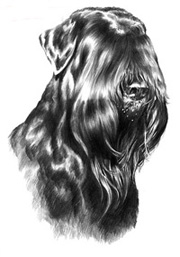
Breed
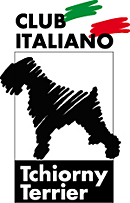
Nuovo Standard TERRIER NERO RUSSO
STANDARD RUSSO del 13/10/2010
approvato FCI il 10/01/2011
Vedi il nuovo standard
Di seguito nella pagina è riportato ancora il vecchio standard, in corso di aggiornamento 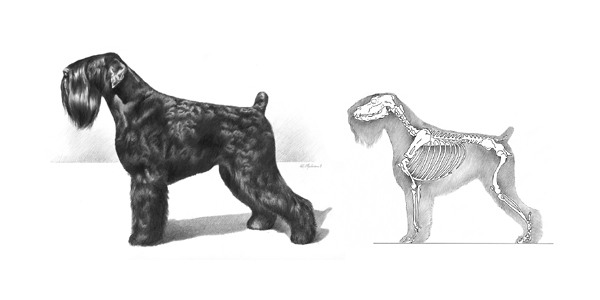
PAESE D'ORIGINE: Ex Unione Sovietica
IMPRESSIONE GENERALE: il Terrier Nero è più grande della media delle altre razze terrier, robusto con ossatura solida e muscolatura ben sviluppata.
Possiede un pelo denso, leggermente ondulato, non riccio o pendente.
Tipico per il Terrier Nero è il suo comportamento riservato verso gli estranei, ma senza aggressività. E' tenace, si adatta facilmente a diverse condizioni climatiche ed è molto docile. Sono resistenti e si adattano alle diverse condizioni climatiche. Sono facilmente addestrabili.
Caratterizzazione sessuale molto marcata: il maschio è più grande e più massiccio della femmina.
ORIGIN: Russia
GENERAL APPEARANCE: The size of the Black Terriers is larger than an average dog. Black Terriers are strong, with massive bone structure and well-developed muscles. The skin is tight and elastic, without any folds or dewlap.
Dogs of this breed are assertive, wary of strangers and resistant; they adjust easily to different climates. The Black Terrier must yield to training.
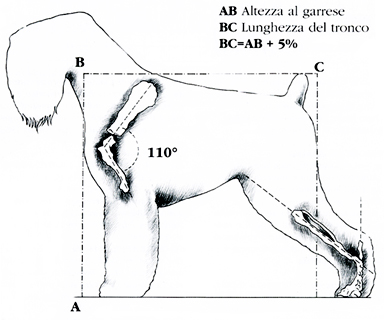
TIPO di COSTITUZIONE: Forte e forte rozzo.
Difetti: Costituzione fisica un po’ leggera e poco sviluppata, muscolatura non abbastanza ben sviluppata.
Difetti gravi: ossatura leggera, muscolatura debole, debole costituzione fisica.
INDICE di FORMATO: 100-105
Difetti: formato allungato (piu’ di 108)
ALTEZZA al GARRESE: per gli stalloni, 66-72 cm, per le cagne, 64-70 cm
Difetti: un po’ tozzo o slanciato. L’altezza al garrese per gli stalloni minore di 66 cm e superiore di 74 cm, per le femmine minore di 64 cm e superiore di 70 cm.
Difetti gravi: costruzione molto alta sugli arti posteriori, costruzione molto bassa sugli arti anteriore. L’altezza al garrese per gli stalloni minore di 65 cm, per le femmine minore di 63.
PARTICOLARITA’ di COMPORTAMENTO: Sistema nervoso forte, equilibrato, vivace, e reazione alla difesa in forma attiva.
Difetti: timore, fiacchezza, sovreccitazione.
TIPO di SESSUALITA: Ben formato in base al proprio sesso. Gli stalloni sono piu’ massicci, grandi e virili rispetto alle femmine.
Difetti: leggere deviazioni verso la tipologia dell’altro sesso.
Difetti gravi: vistose deviazioni verso la tipologia dell’altro sesso. Criptorchismo parziale o totale. Ghiandole dell’apparato genitale sottosviluppate. Stalloni di dimensioni e forme di una cagna.
MANTELLO: Per il cane a pelo lungo, il mantello e’ ispido, ma aderente al corpo. Il mantello si presenta irregolare e copre ogni parte del corpo. La lunghezza del pelo varia tra 4-10 cm. Il pelo del collo e sulla groppa forma una criniera. Gli arti anteriori, fino al gomito e quelli posteriori sino alle cosce, sono ben protetti da un folto e ispido pelo. Il pelo di ornamento e’ ben sviluppato. Sul muso, il pelo ispido di ornamento forma dei “baffi” (sul labbro superiore), una “barba” (sul labbro inferiore) e “sopracciglia” (sopra gli occhi). Il sottopelo e’ ovunque folto e ben sviluppato. Il pelo si presenta dritto, ispido, ben aderente e folto.
Difetti: pelo diritto e uniforme, morbido e ondulato, con lunghezza maggiore di 10 cm. Pelo insufficientemente folto sulla testa e sulle estremita’. Pelo arricciato.
Difetti gravi: pelo piu’ lungo di 15 cm, morbido e cadente. Mancanza di pelo folto sulla testa o estremita’ e anche la mancanza degli ispidi “sopraccigli”, “baffi” e “barba”.
Colore: Nero o nero con sfumature bianche.
Difetti: colore leggermente marrone-grigio o grigio. Piccole chiazze bianche sul torace.
Difetti gravi: colore vistosamente marrone-grigio o grigio. Presenza di chiazze bianche al mento, sulla testa, sul collo e alle estremita’.
PHYSICAL APPEARANCE: Robust and rustic.
Faults: Feeble or fragile appearance, insufficient muscle tone.
Major faults: Light bone structure, weak muscle tone, frail and weak constitution.
INDEX OF THE FORMAT: The proportion of the length of the body vs. the height at the withers is 100 : 105.
Faults: Format slightly too large (106:108)
Major faults: Format too large (in excess of 108)
HEIGHT AT THE WITHERS:
Male dogs: 25.7 - 28.1 inches (66 - 72 cm)
Bitches: 25.00 - 27.3 inches (64 - 70 cm)
Faults: Slightly leggy or short on the legs. Height at withers of male dogs below 25.7 inches (66 cm) or above 28.1 inches (72 cm); height at the withers of bitches below 25.0 inches (64 cm) or above 27.3 inches (70 cm).
Major faults: Rump set too high or withers too low. Height at withers of male dogs below 25.4 inches (65 cm) or above 28.9 inches (74 cm); height at withers of bitches below 24.6 inches (63 cm) or above 28.1 inches (72 cm).
BEHAVIOUR/TEMPERAMENT: Extremely energetic, hardly, stable temperament, but very lively, with strong reactions of defense.
Faults: Timid, excessively excitable, passive.
Major faults: Fearful, extremely excitable, extremely passive.
CHARACTERISTICS TYPICAL FOR EACH SEX:
Clearly expressed, depending on the sex. Male dogs are of greater size, more masculine and more massive than bitches.
Faults: Minor deviation from the required sexual characteristics.
Major faults: Strong deviation from the required characteristics. Male with a feminine appearance or vice versa.
COAT: The hair is rough, hard, ample and extremely dense. The broken’s hair length is between 1.6 and 3.9 inches (4 - 10 cm) and covers the entire body. On the muzzle, the coat froms a rough, brushy moustache on the upper lip and a beard on the lower lip. Above the eyes, the eyebrows are rough and bristled. On the neck and the withers, the coat is longer and forms a mane. The forelegs down until the elbows and the hind legs until the things are covered by a rough and long coat. The undercoat is dense and well-developed.
Faults: Straight hair, not broken. Wavy hair, soft hair, hair longer than 3.9 inches (10 cm). Insufficient formation of moustache, beard or eyebrows. Frizzy hair,
Major faults: Hair too long (in ecxess of 5.9 inches (15 cm)), soft hair, falling hair, short hair, smooth hair; absence of coat developments on head or legs.
Colour: Black or black with gray hairs.
Faults: Brown or gray shadings, small white spot on chest.
Major faults: Brown or gray coat, reddish patches; white spots on chin, head, neck and legs.
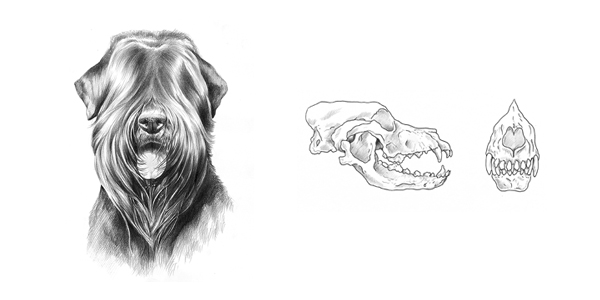
Difetti: testa un po’ leggera, con fronte sporgente, poco o troppo evidenziato il passaggio tra fronte e muso. Zigomi troppo sporgenti. Labbra umide.
Difetti gravi: testa leggera, pesante o rozza e di forma sferica. Muso corto, sporgente verso l’alto o appuntito.
ORECCHIE: Attaccatura in alto, appese alle cartilagini, di forma triangolare, non grandi, aderenti agli zigomi con i lembi anteriori.
Difetti: attaccatura troppo in basso, lunghe, “arruffate”, vistosamente sporgenti.
Difetti gravi: troppo sostenute sulle cartilagini, afflosciate per circa la meta’ della loro lunghezza.
OCCHI: Non troppo grandi, di forma ovale, obliqui, scuri.
Difetti: occhi grandi, ma non sufficiente scuri, albugine, terza palpebra vistosa o palpebre cadenti.
Difetti gravi: occhi chiari. Strabismo.
DENTI: Grandi, bianchi, fitti (senza spazi interdentali). Incisivi ben allineati. La commessura a forbice.
Difetti: denti troppo consumati rispetto all’eta’ dell’esemplare, l’esistenza di denti rotti, che pero’ non modificano la giusta commessura, un po’ di placca gialla (tartaro).
Difetti gravi: denti piccoli, non fitti. Incisivi non allineati alla base, tutte le deviazione dalla commessura a forbice, assenza di qualche dente.
Faults: Head too small, forehead rounded, stop hardly marked or excessively pronounced, protruding cheekbones, soft lips.
Major faults: Coarse head, too light or too heavy, rounded head; muzzle short, pointed or turned-up.
EARS: Attached high on the head, hanging down straight form the base, small and triangular in shape. The front rim of the ear hangs down against the cheekbones.
Faults: Ears set too low; long ears, flying ears, ears held apart from the cheekbones.
Major faults: Ears standing up from the base, semi-erect ears.
EYES: Small, oval shaped, slanted, dark in colour.
Faults: Big eyes or eye colour not sufficiently dark. Visible third eyelid. Visible haw. Presence of a milky spot on the eye.
Major faults: Light coloured eye, cross-eyed.
TEETH: Strong, white in colour, closely positioned. The incisors are positioned in one line, the bite is a scissors bite.
Faults: Poorly developed teeth, teeth not corresponding with age, damaged teeth which do not interfere with the proper occlusion of the bite. Absence of up to two of the first premolars or absence of one of the first premolars and one of the second premolars. Light tar build-up.
Major faults: Very small teeth, missing teeth; incisors not aligned; any deviation from a scissors bite; absence of an incisor or a canine, absence of a third or a fourth premolar or any molar. Teeh with severely damaged enamel.
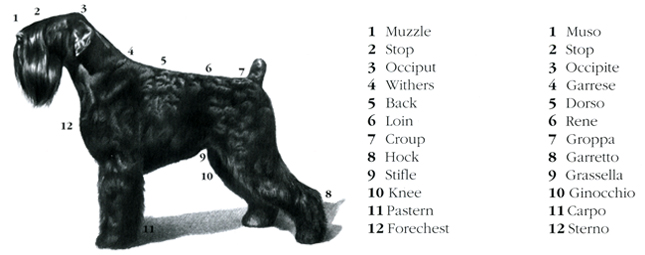
Difetti: collo corto, caricato, pendente, messo troppo basso.
TORACE: Largo, profondo, con qualche costola sporgente. La parte bassa e’ in linea o un po’ in basso con i gomiti degli arti anteriori.
Difetti: torace non sufficientemente ampio e leggermente non in linea con i gomiti degli arti anteriori. Costole un po’ piatte.
Difetti gravi: torace ricurvo a botte troppo sporgente, troppo piccolo, piatto. Oppure torace troppo stretto.
VENTRE: Ricurvo verso l’interno. Disposto piu’ in alto rispetto alla linea del torace.
Difetti: ventre troppo ricurvo verso l’interno o abbassato.
GARRESE: Alto e marcatamente ripido sul dorso.
Difetti: garrese basso e poco sviluppato (esile).
DORSO: Ampio, dritto, muscoloso.
Difetti: dorso morbido, stretto e di flaccida muscolatura.
LOMBO: Corto, ampio, muscoloso, un po’ sporgente.
Difetti: lombo lungo, non sufficientemente sporgente.
Difetti gravi: lombo incurvato verso il basso o verso l’alto, stretto.
GROPPA: Larga, muscolosa, un po’ discendente verso la coda rivolta verso l’alto.
Difetti: groppa orizzontale, un po’ storta, di flaccida muscolatura.
Difetti grave: groppa stretta, troppo storta.
CODA: Rivolta verso l’alto, grossa e troncata (mozza: 3-4 vertebre).
Difetti: coda rivolta il basso, mozzata in modo errato.
Difetti gravi: coda non mozzata.
ARTI ANTERIORI: Frontalmente devono essere paralleli tra loro e dritti e l’angolo dell’articolazione della scapola deve essere circa 110 gradi. I gomiti devono essere decisamente rientranti. Gli avambracci dritti, grossi con metacarpi corti e dritti.
Difetti: le spalle sono poco arrotondate e i gomiti rientrano o sporgono appena un po’, i metacarpi molli, arti anteriore orientati verso l’interno o all’esterno.
Difetti gravi: le spalle piatte, i gomiti molto sporgenti, avambracci ricurvi, i metacarpi fragili.
ARTI POSTERIORI: Posteriormente devono essere dritti, paralleli tra loro, leggermente piu’ allargati rispetto a quelli anteriori. I fianchi sono muscolosi e ben sviluppati. L’articolazione del ginocchio ben evidenziata. I metatarsi sono massicci, lunghi e quasi a piombo.
Difetti: la muscolatura non molto sviluppata; i garretti corti; le articolazioni delle ginocchia sono un po’ rientrati o sporgenti; lombi posteriori leggermente appiattiti o scarni; un numero superiore di dita.
Difetti gravi: gli stessi difetti descritti precedentemente, ma in forma piu’ accentuata; lombi posteriori troppo alti; lombi posteriori troppo appiattiti o troppo scarni.
ZAMPE (ANTERIORI e POSTERIORI): Grandi, di forma arrotondata, tendono a rimanere in posizione ravvicinata creando un unico ammasso peloso.
Difetti: le zampe divaricate.
Difetti gravi: le zampe sono appiattite o molto divaricate.
ANDATURA: Libera, armoniosa e leggera. Caratteristico e’ il trotto andante e il galoppo. Al galoppo i movimenti degli arti sono lineari, e gli arti anteriori convergono verso la linea di mezzeria; dorso e lombi posteriori hanno movimenti molleggiati.
Difetti: leggera deviazione dalla linearita’ dei movimenti. Articolazioni non sufficientemente elastiche.
Difetti gravi: movimenti pesanti e legati. Il cane procede con andatura irregolare e sbilanciata su un fianco. Groppa (e lombi posteriori) troppo oscillante durante l’andatura. Ambio.
DIFETTI GRAVI DA SQUALIFICA: Tutte le deviazioni della commessura a forbice; criptorchismo parziale o totale; apparato ghiandolare di riproduzione non sviluppato; colore grigio o pezzato, zampe bianche, mantello irregolare; mancanza del terzo o del quattro premolare oppure di un molare.
Faults: Short neck, blocky neck, showing a dewlap or held low.
CHEST: Large, deep showing several well-sprung ribs. The lower part of the chest is positioned at the level of the elbows or slightly below this level.
Faults: Ribs not well sprung, chest not descending to the level of the elbows, ribcage slightly flat.
Major faults: barrel shaped ribcage, too wide, not enough let down, flat or narrow.
ABDOMEN: Set above the lower line of the chest.
Faults: Strongly tucked-up or whippety abdomen.
WITHERS: High, clearly marked above the dorsal topline.
Faults: Low, poorly developed withers.
BACK: Straight, large, muscular.
Faults: Weak back, narrow or insufficiently muscled.
Major faults: Concave or convex back.
LOIN: Short, wide muscular and slightly arched.
Faults: Long, insufficiently rounded.
Major faults: Badly coupled, narrow or very arched.
RUMP: Large, muscular, with a barely visible slope towards the tail, which is set high on the croup.
Faults: Horizontal rump or slightly sloping rump, insufficiently muscled.
Major faults: Slanting or narrow rump.
TAIL: Set high, thick and docked short, leaving 3 to 4 vertebrae.
Faults: Tail set low, incorrectly docked tail.
Major faults: Tail not docked.
FOREQUARTERS: Seen from the front, the legs are straight and parallel. The angle of the shoulder-blade with the upperarm is approximately 110 degrees. The elbows must point backwards. The forearms are short and vertical. The pasterns are short and straight.
Faults: Shoulder slightly too straight, elbows slightly turned inwards or outwards; pasterns weak, outwards or inwards.
Major faults: Upright shoulder; strong deviation of the elbows; deviation of the forearm; knuckling over, down or pastern.
HINDQUARTERS: Seen from behind, the legs are straight and parallel, but held more wide than the front legs. The thighs are muscular and well developed. The lower thighs are long and set obliquely. The hock joint is dry and well developed. The hocks (metatarsals) are massive, long and almost vertical.
Faults: Weak muscle tone, short legs, slightly cow hocked legs (or bow-legged). Angulations slightly too straight or the angle at the hock too narrow. Hare feet.
Major faults: The same as above, but more pronounced. Rump too high. Hock joints perfectly straight or with a very narrow angulation.
FEET: (Fore-and hind feet): Thick, with well arched pads, rounded in shape.
Faults: Feet pointing outwards or inwards.
Major faults: Feet flat or crooked.
MOVEMENT: Easy, harmonious and fluid. A slow trot or the gallop are the most typical movements. When trotting, the legs must move in a straight line, with the front legs converging towards a median line. The back and the loin show an elastic movement.
Faults: Slight deviation from the requirement that the legs move in a straight line. Insufficient extension of the front or hind legs.
Major faults: Restricted or clumsy movement, movement of the hind legs not straight (crab-like movement), unbalanced movement of the rump (rolling movement of the hindquarters, pacing movement).
DISQUALIFYING FAULTS: Any deviation from the scissorts-bite requirement. Parti-coloured coat. White markings on feet. Red patches. Gray coat. Absence of an incisor or a canine. Absence of any third premolar or any fourth premolar. Absence of any molar.
N.B. Male animals should have two apparently normal testicles fully descended into the scrotum.

